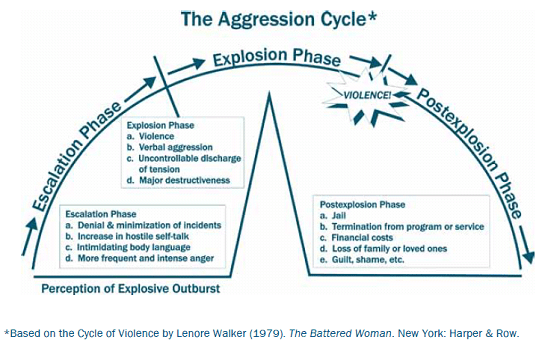There are three phases of an anger episode:
- Escalation
- Explosion
- Post-Explosion.
Together, they make up the aggression cycle.
Escalation
The escalation phase involves cues that indicate anger is building. As stated in introduction to anger management, these cues can be physical, behavioural, emotional, or cognitive (thoughts).
Cues are warning signs or responses to anger-provoking events. These events are situations that can occur daily and may lead to the escalation of anger if effective anger management strategies are not used early on.
Red-flag events are situations unique to you. They can be triggered or influenced by past events. These events can involve internal processes (thinking about situations that provoked anger in the past) or external processes (present anger provoking situations).
Explosion
If the escalation phase goes unmanaged, the explosion phase will follow. The explosion phase is marked by an uncontrollable display of anger; verbal or physical aggression. This display of anger can lead to negative consequences. This is equivalent to the number 10 on the ‘anger meter.’
The anger meter is presented below. It’s a scale (or thermometer) ranging from 1 – 10, where 1 is calm and 10 correlates to explosive anger. It’s important to recognise if you are reaching anger levels of four or five (the escalation phase) and establish strategies to prevent your score from going any higher.

Post explosion
The final stage of the aggression cycle is the post-explosion phase. It consists of the negative consequences of the verbal or physical aggression displayed during the explosion phase.
These consequences may include feelings of guilt, shame and regret, losing family and loved ones, being terminated from a job, or going to jail.
What it may look like
The intensity, frequency and duration of anger in the aggression cycle varies among individuals. For example, one person’s anger may escalate rapidly after a provocative event and, within just a few minutes, reach the explosion phase. Another person’s anger may escalate slowly but steadily over several hours before reaching the explosion phase. Similarly, one person may experience more episodes of anger and progress through the aggression cycle more often than the other. However, both individuals, despite differences in how quickly their anger escalates and how frequently they experience anger, will undergo all three phases of the aggression cycle.
The intensity of anger also may differ. One person may engage in more violent behaviour in the explosion phase than others. For example, he or she may use weapons or assault someone. Another person may express their anger during the explosion phase by shouting at, or threatening, other people. Regardless of these individual differences, the explosion phase is equivalent to losing control and becoming verbally or physically aggressive.
Notice that the escalation and explosion phases of the aggression cycle correspond to the levels on the anger meter. The points below 10 on the anger meter represent the escalation phase – the ‘building up’ of anger.
The explosion phase, on the other hand, corresponds to 10 on the anger meter. 10 on the anger meter is the point at which one loses control and expresses anger through verbal or physical aggression that leads to negative consequences.
Not reaching the explosion phase
One of the primary objectives of anger management treatment is to keep yourself from reaching the explosion phase. As mentioned, this is accomplished by using the anger meter to:
- Monitor changes in your anger
- Notice the cues or warning signs that indicate anger is escalating
- Use appropriate strategies from your anger control plan to stop the escalation of anger.
If the explosion phase is prevented from occurring, the post-explosion phase will not occur, and the aggression cycle will be broken. If you use your anger control plan effectively, your anger should ideally reach between a 1 and a 9 on the anger meter. This is a reasonable goal to aim for. By preventing the explosion phase (10), you’ll not experience the negative consequences of the post-explosion phase, and you’ll break the cycle of aggression.

Still need help?
Anglicare Southern Queensland provides advocacy, support and counselling programs for victims/survivors of domestic and family violence and targeted behaviour change and counselling programs for men who use domestic violence and abuse against family members. Access Anglicare Southern Queensland’s Family and Relationship Services or the Living Without Violence program, in Brisbane, if you think you would benefit from some counselling or support around this issue.
Other articles in this section
